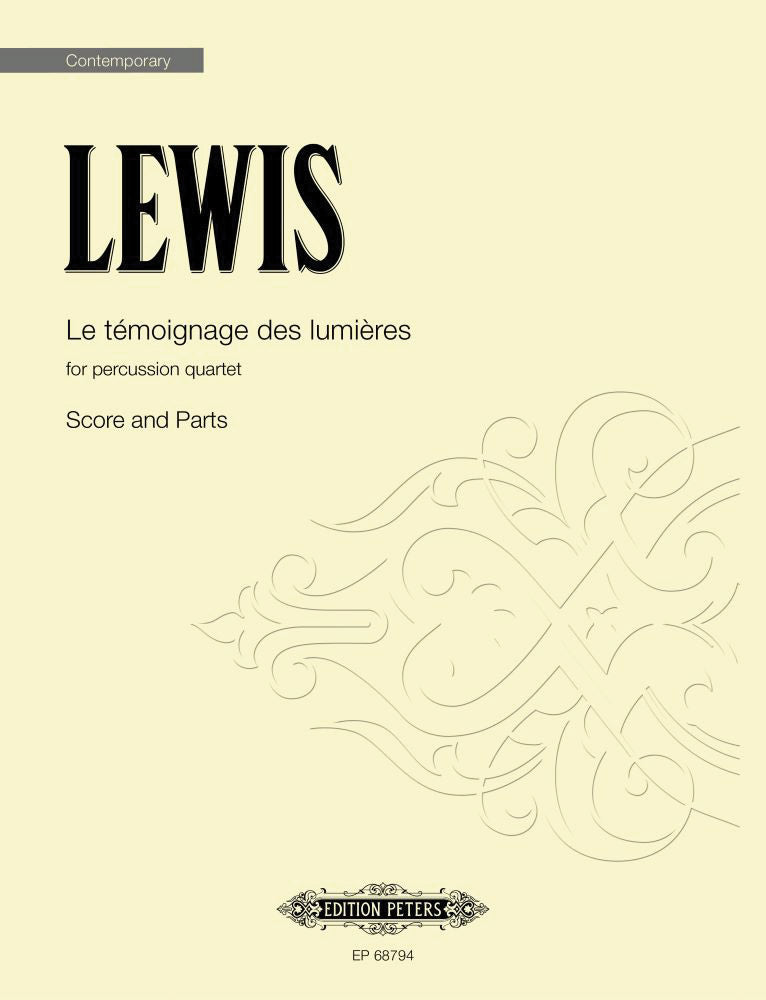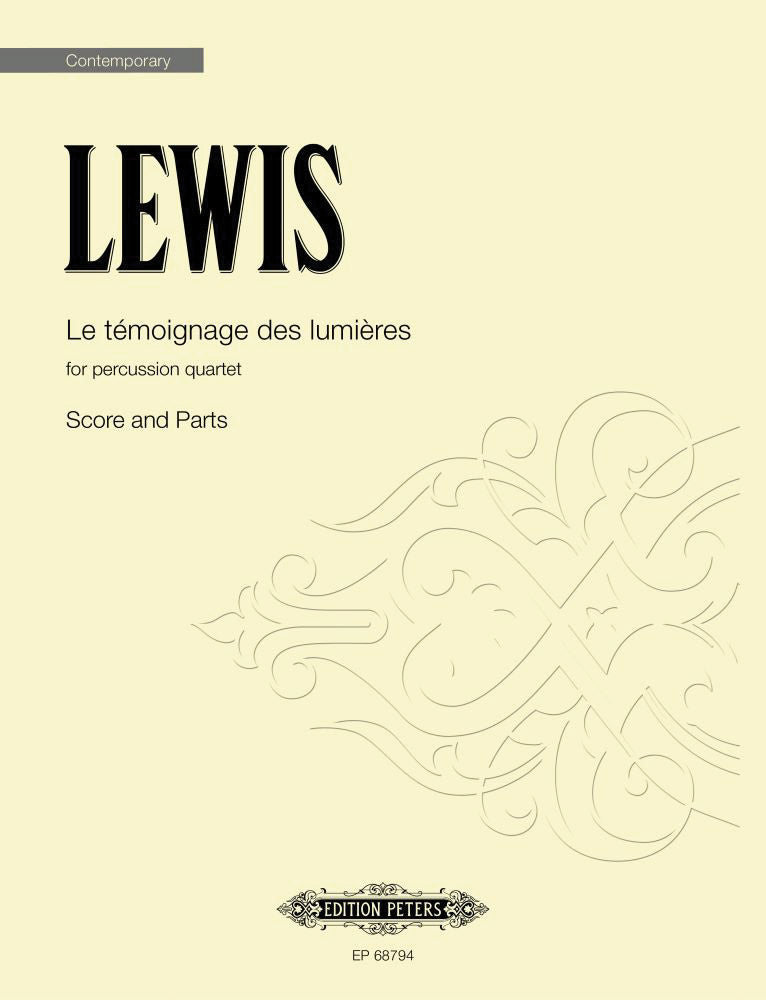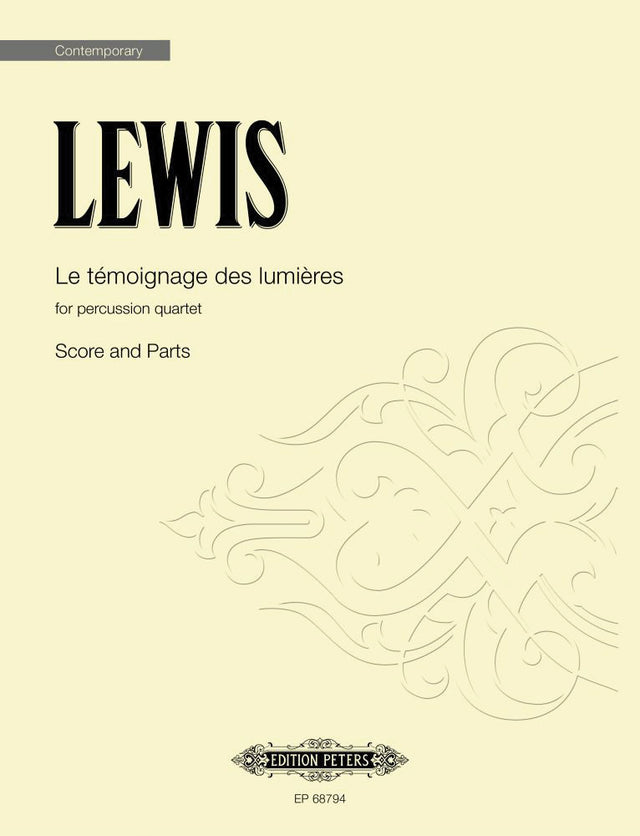George Lewis
Lewis: Le témoignage des lumières
- Composer: George Lewis (1952-)
- Format: Score & Set of Parts
- Instrumentation: Percussion Ensemble
- Work: Le témoignage des lumières (2022)
- ISMN:
- Size: 8.9 x 12.0 inches
- Pages: 68
Description
Commissioned by Tanglewood Music Center and the Isabella Stewart Gardner Museum
With special thanks to George Steel, and a farewell present to Ellen Highstein
In 2004 I visited Gorée Island, near Dakar, Senegal. Over a period of nearly four hundred years, Gorée was the largest slave-trading center on the African coast. Both the deplorable slave quarters and the elegant mansions of the traders are on view there today, as well as a museum with artifacts of the period-chains, shackles, and original documents. Here, I learned that the French word négrier, which explicitly references blackness, denoted both the traders and the vessels they used to transport their cargo of African humans from Gorée's famed "point of no return"-quite often to Nantes in Bordeaux, a principal slave trading stopover from the time of Louis XV to the rule of Napoleon.
The sound of Le témoignage des lumières (The Testimony of Lights) work situates itself within the classic American trope of depiction, among such forebears as Charles Ives, Amy Beach, Duke Ellington, Elliott Carter, and Blind Tom. From the opening moments, listeners find themselves virtually on board a négrier, where we hear not only the sonic testimony of the ship, but also the appalling violence and objectification of human beings that financially supported the Age of Enlightenment--in French, Le siècle des Lumières, the century of lights.
Confronting this staggering moral contradiction in music and scholarship is part of my exploration of what decolonization might sound like, as classical music develops an expanded notion of its history and identity, a new "we" that could be the field's greatest promise.
Publishers use a lot of words to describe what they sell, and we know it can be confusing. We've tried to be as clear as possible to make sure you get exactly what you are looking for. Below are descriptions of the terms that we use to describe the various formats that music often comes in.
Choral Score
A score for vocalists that only contains the vocal lines. The instrumental parts are not there for reference. Generally, cheaper than a vocal score and requires multiple copies for purchase.
Facsimile
Reproductions of the original hand-written scores from the composer.
Full Score
For ensemble music, this indicates that the edition contains all parts on a single system (there are not separate parts for each player). In larger ensembles, this is for the conductor.
Hardcover
Hardbound. Generally either linen-covered or half-leather.
Orchestral Parts
Similar to a wind set, this is a collection of parts. In the case of strings, the numbers listed are the number of copies included, though generally these are available individually (often with minimum quantities required).
Paperback
When publishers offer multiple bindings (e.g. hardcover) or study scores, this is the "standard" version. If you're planning to play the music, this is probably what you want.
Performance / Playing Score
A score of the music containing all parts on one system, intended for players to share. There are not separate parts for each player.
Set of Parts
For ensemble music, this indicates that there are separate individual parts for each player.
Solo Part with Piano Reduction
For solo pieces with orchestra, this is a version that contains a piano reduction of the orchestra parts. For piano pieces, two copies are typically needed for performance.
Study Score
A small (think choral size) copy of the complete score meant for studying, and not playing. They make great add-ons when learning concertos and small chamber works.
Vocal Score
A score prepared for vocalists that includes the piano/organ part or a reduction of the instrumental parts.
Wind Set
For orchestral music, this is a collection of wind and percussion parts. The specific quantities of each instrument are notated.
With Audio
In addition to the printed music, the edition contains recordings of the pieces. This may be an included CD, or access to files on the internet.
With / Without Fingering (Markings)
Some publishers prepare two copies - a pure Urtext edition that includes no fingering (or bowing) suggestions and a lightly edited version that includes a minimal number of editorial markings.




